If you ask anyone, including kids, about the colors of peacocks’ feathers, the most common answer you would get is blue and green.
The majestic image of blue-green peacocks with their shiny plumage and spotted tail feathers has also been glamorized by media, films, cartoons, and even comics.
But not everyone knows what species these famous blue-green peacocks belong to and how they actually live. So, let’s shed some light on this topic once and for all.
These beautiful, blue-green peacocks or peafowls are called Indian Peafowl, Common Peafowl, and Indian Blue Peafowl. They are also scientifically known as Pavo cristatus.
Indian peafowls originated in Sri Lanka and India. But they can also be found in other regions such as Kashmir, Pakistan, Malaya, Nepal, Burma, Java, and the Congo.
To learn more about Indian peafowls, let’s dive in deeper and look at the history of these magnificent birds.
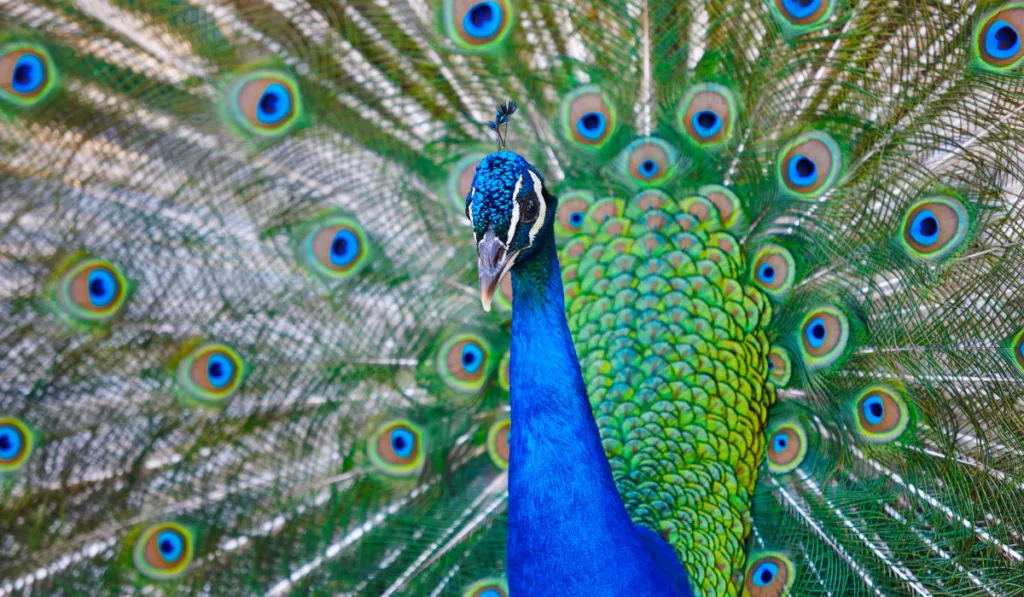
Table of Contents
The History of Indian Peafowl
From a historical perspective that can be traced back to the 10th-century B.C.E., the Indian Peafowl is considered the oldest ornamental bird in the world.
These birds were first introduced into the Mesopotamian world around 4,000 years ago, but people from China were the first to import and domesticate Indian peafowl. Phoenician traders also brought these birds to Egypt (around 3,000 years ago) before they were introduced to the Mediterranean regions.
What’s more interesting was that back around 1,000 B.C.E., King Solomon of Israel and Judah were among the first people to own and keep these birds.
The Indian peafowl also plays a significant role in religion, culture, art, and literature. This can be seen in the Hindu religion, which worships the holiness and beauty of the peacock as a recurring ideal and symbol in much of its mythology and folklore.
For instance, Hindu people believe that peacocks are the embodiment of some forest god due to birds’ voices and cries that warn many village people about incoming danger from tigers and other animals.
In Hinduism, you can also see that the god of war, Lord Kartikeya used peacocks as his mounts, and the feathers of these birds were also worn by Lord Krishna. Not to mention, there’s an old proverb in Hindu culture that goes, “the peacock has the feathers of an angel, the voice of the devil, and the walk of the thief.”
In art and literature, peafowls are also symbolized and viewed with many interpretations.
For instance, in Aesop’s fables, peacocks have been portrayed as prideful creatures because of their beautiful plumage and fan-like tail feathers. In paintings, peacocks were also viewed as a symbol of vanity and beauty.
The philosopher and scholar Aristotle also recorded many notes on the behavior and appearance of these beautiful birds. But it was merely for study and research.
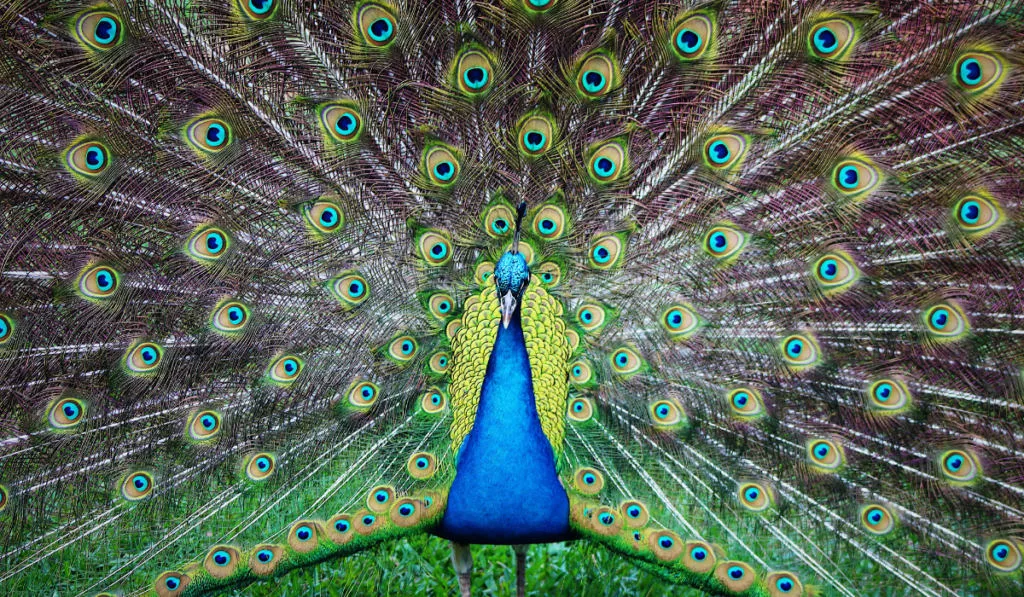
Indian Peafowl Characteristics
The Indian Peafowl belongs to the family Phasianidae. Male peafowls are known as peacocks, while females are called peahens.
Peacocks generally weigh between 9 and 13 pounds and can grow up to 46 inches long from bill to tail. Meanwhile, peahens weigh between 6 to 9 pounds and can grow up to 38 inches long.
Peacocks have attractive blue-green, shiny plumage, and metallic blue heads, with a fan of large-spotted tail feathers that measures around 5 feet wide.
On the other hand, females are slightly different, with brown, cream, and gray plumage, greenish necks, and white underparts. The only thing that both sexes share is the crest on their head.
Young peafowl may look similar to peahens. But if you look closer, they generally have pale, buff feathers, with chestnut-colored wings and dark brown marks around their eyes.
There are also three variations of Indian blue peafowl: the common peafowl, the pied peafowl, and the black-winged peafowl. Pied peafowls have white feathers but are not albinos, and black-winged peafowls have exotic, dark feathers with blue and green tips.
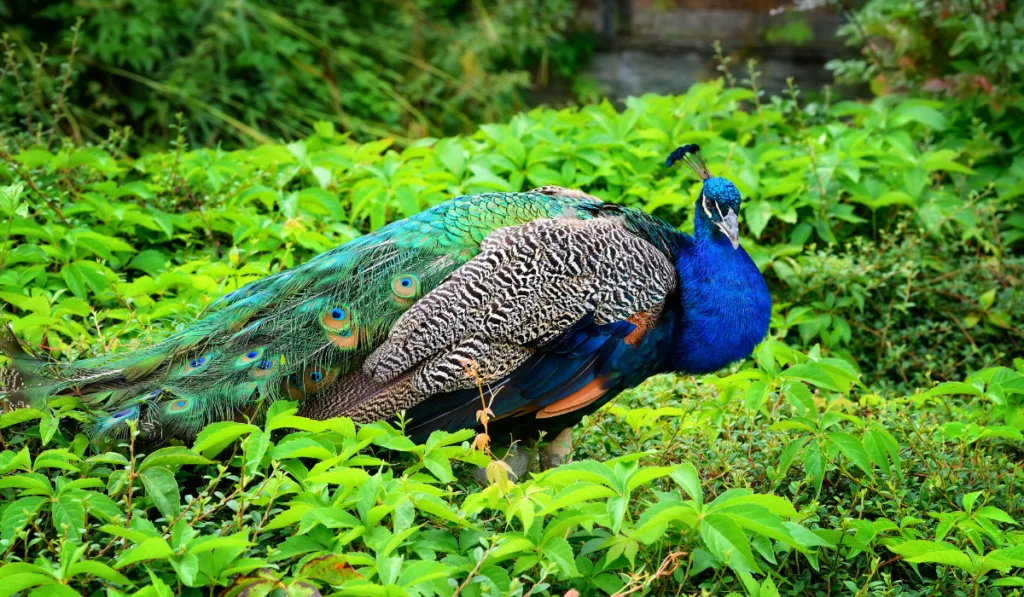
Distribution and Natural Habitat of Indian Peafowl
You can find the Indian peafowl inhabiting shrubby areas, semi-desert grasslands, open deciduous forests, and riparian regions (river banks).
In South Asia, these birds can be found living at an altitude of 1,800 meters (5,490 feet), with the highest elevation being around 2,000 meters (6,100 feet).
Peafowls rarely migrate or travel too far from where they originally lived. Although Indian peafowls prefer moist or dry forests, they can also be found in settled regions and villages, especially in areas with clean sources of water.
In many parts of northern India, these birds are protected by religious centers and are able to roam freely around the place.
Today, there are around 100,000 Indian peafowls that can be found in the world. Their population has become stable, and the International Union for Conservation of Nature (IUCN) decided to list them under the category of “Least Concern.”
Aside from South Asia, these birds have also been brought to other places such as Portugal, Madagascar, Brazil, South Africa, Argentina, Uruguay, Mexico, Honduras, Croatia, Australia, Papua New Guinea, and the United States.
Indian peafowl generally can survive in regions with colder climates, such as Britain and northern Canada. However, in damp and cold environments, they rarely thrive.
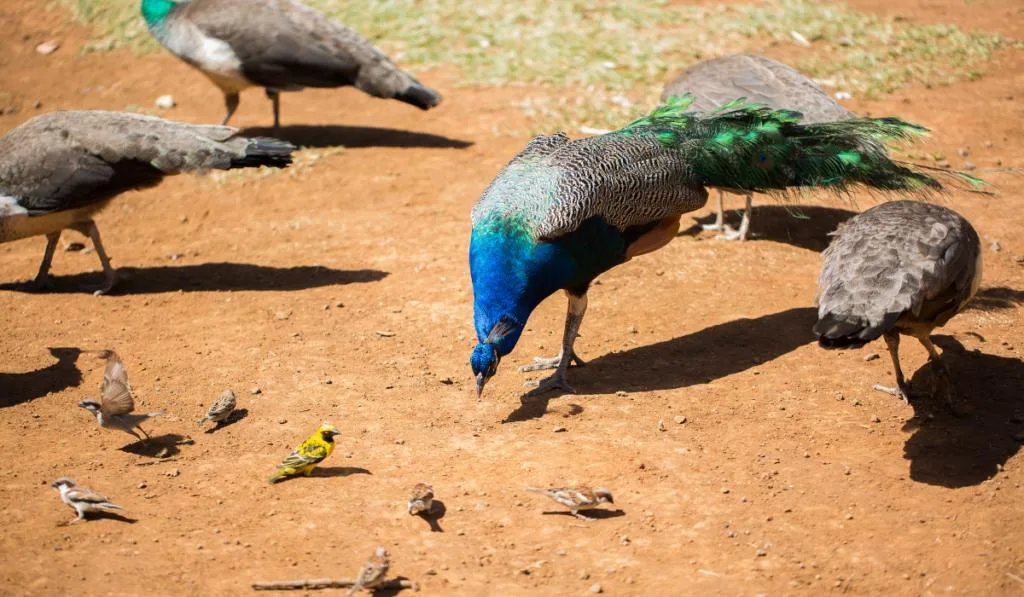
Behavior and Feeding Habits
Indian peafowls are considered to be omnivorous birds. In the wild, they will eat anything that they can find in their habitat. Things they eat include berries, seeds, grains, insects, flowers, parts of plants, small reptiles, small mammals, and amphibians.
These birds spend most of their time on the ground in search of food. When foraging for food, Indian peafowl usually move in a small group that consists of at least one peacock and three to five peahens. They will also move in single file to drink water in their chosen spots.
If these birds are disturbed or sense any incoming danger from predators, they won’t fly to escape. Instead, the quickest way for them to save themselves is by running.
At night, Indian peafowl will perch and roost in tall trees or on higher places such as rocks, pylons, and buildings. You may also hear their loud calls when neighboring birds start to make a sound or they sense any danger.
Peafowl calls usually sound like a loud “may-awe,” “pia-ow,” and rapid calls that sound “kok-kok” and “ka-aan-ka-aan.”
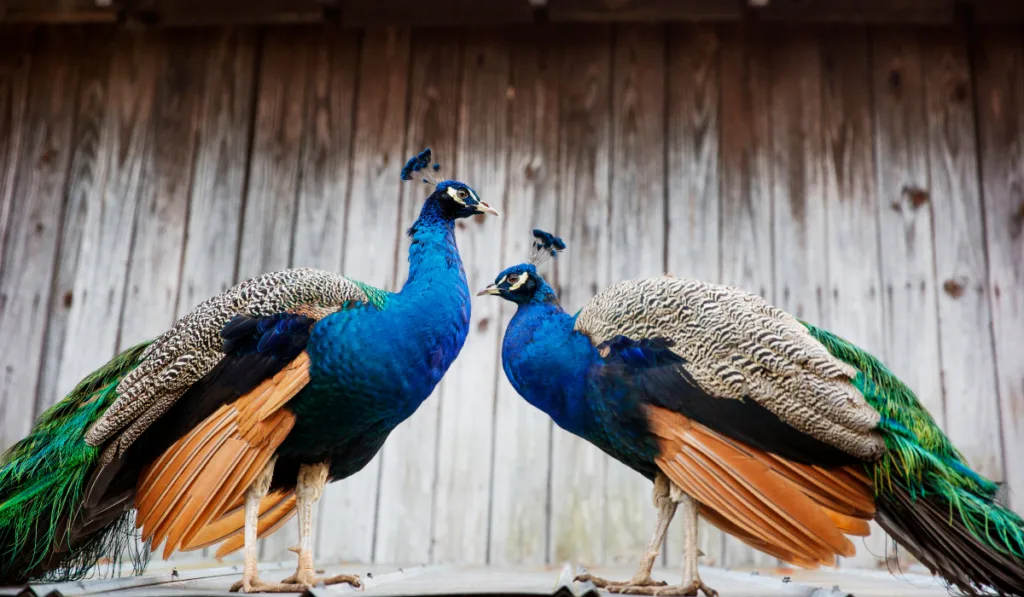
Mating and Breeding
Male Indian peafowl or peacocks are polygamous creatures, and they have to work hard to attract potential mating partners. Peahens are ready to mate when they reach the age of 2 or 3 years old.
During mating season, peacocks will use loud calls and fan out their big and beautiful train (tail feathers) to attract between two and three peahens. They will also freeze over food to attract peahens through courtship feeding.
We tend to assume that peacocks with the largest trains or the most number of spots on their trains will be perceived as the prime candidate for mating. However, peahens don’t necessarily have a specific type, and they can even mate with peacocks that are less attractive.
Different regions also have different peak seasons for mating. In Sri Lanka, the peak season is from January to March. In northern India, June is the peak season for mating, and in southern India, the peak mating season lasts from April to May.
Peahens usually lay between four and eight fawn or buff-white eggs. After mating, they will scrape out a hollow in the ground or in hidden shrubs before lining them with sticks, leaves, substrates, and debris. It takes between 28 and 30 days to incubate the eggs.
Only peahens are responsible for incubating the eggs and taking care of the chicks when they hatch. Most of the time, downy young will only follow their mothers. They will also climb on their mother’s back before their mother flies to perch on safer or higher places.
When the peachicks reach the age of 4 weeks, they will develop their crests. After two months, they will look similar to peahens but much smaller in size.
In the wild, healthy peafowls can live up to 25 years. However, if there’s any threat from predators, their average lifespan will be reduced to 20 years.
In captivity, peafowl may have a shorter lifespan, which is between 16 and 23 years. This is because of their sedentary lifestyle, which is less healthy than the ones that live in the wild.
For instance, wild peafowl will roam freely and forage for food. Meanwhile, peafowls in captivity don’t have to constantly search for food. Hence, they don’t burn a lot of fat and protein, are less active, and are prone to suffer from gout and kidney failure.
Final Thoughts
Unlike other peacock breeds, the Indian peafowl may be the only species that you can’t suitably raise as pets. This is due to the fact they are categorized as one of the many endangered birds. Furthermore, like many wild birds, these peafowls may need special attention from trained ornithologists or veterinarians. Hence, it is better to let them live in their natural habitat or in the zoo, under proper keeping and care.
Citations
- https://www.beautyofbirds.com/indianpeafowlpheasants.html
- https://kids.nationalgeographic.com/animals/birds/facts/indian-peafowl
- https://en.wikipedia.org/wiki/Indian_peafowl
- https://animaldiversity.org/accounts/Pavo_cristatus/
- https://petkeen.com/indian-peafowl/
- https://www.denverzoo.org/wp-content/uploads/2018/09/Indian-Peafowl.pdf
- https://www.jungledragon.com/specie/97/indian_peafowl.html
- https://assortedregards.com/2021/07/15/peafowl-in-history-culture
- https://www.digitalvertebrae.com/fall06/daryllf/about_peacocks_hist.html
- https://seaworld.org/animals/facts/birds/indian-peafowl/
- https://animalia.bio/indian-peafowl
